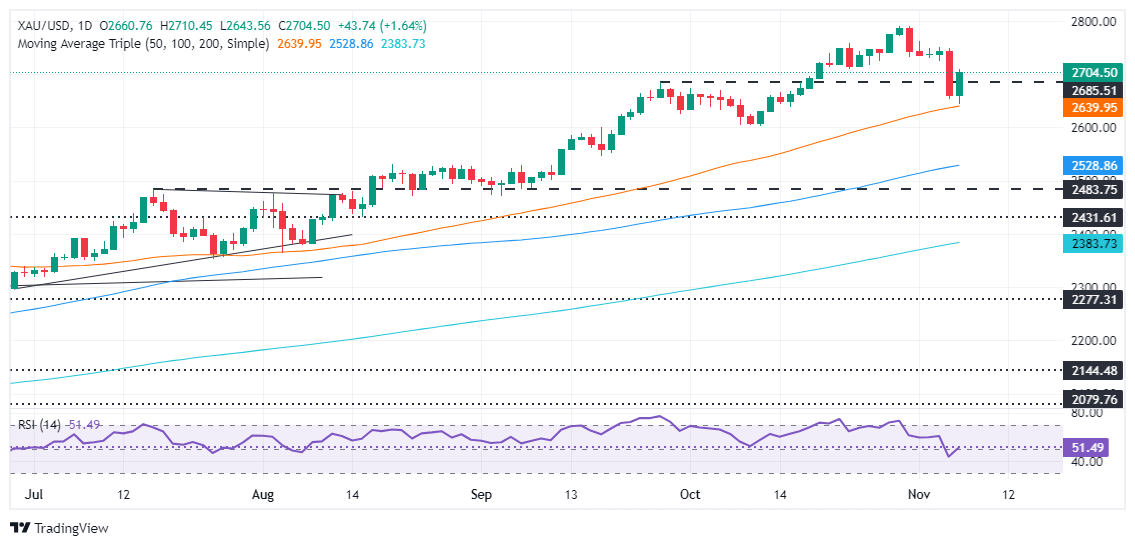- Gold benefited from the Fed’s moderate rate cut and signs of flexibility in the future direction of policy.
- Powell notes that rate cuts could adapt to changes in the labor market, keeping investors cautious.
- The upcoming University of Michigan Consumer Sentiment report and inflation expectations could further impact gold’s momentum.
Gold prices rose above $2,700 after the Federal Reserve (Fed) decided to lower interest rates and recognized that the effects of the US elections will not be felt in the short term. At the time of writing, XAU/USD is trading at $2,704, up over 1.7%.
Wall Street extended its gains after the Fed cut the federal funds rate by a quarter of a percentage point by unanimous decision. In the monetary policy statement, officials acknowledged the strong economic expansion, although labor market conditions eased. They acknowledged that inflation has moved closer to the Fed’s 2% target, but remains somewhat elevated.
Fed policymakers also noted that the risks of fulfilling its dual mandate are “roughly balanced,” but acknowledged uncertainty in the economic outlook. They will remain vigilant against risks on both sides of the mandate.
In his press conference, Jerome Powell avoided giving specific guidance on future rate moves, leaving room for flexibility at the December meeting and beyond. He emphasized that the Fed could afford to take its time in lowering rates because of the strong economy. He acknowledged that policy remains restrictive even after today’s rate cut, as officials aim to bring rates to neutral levels.
As for the pace of rate cuts, Powell mentioned that the Fed could accelerate if the labor market weakens or slows as it moves closer to neutral. However, he clarified that no final decisions have yet been made.
Previously, the U.S. Bureau of Labor Statistics (BLS) reported an anticipated increase in the number of Americans filing for unemployment benefits compared to the previous week.
Looking ahead to the week, the US economic calendar will include the University of Michigan (UoM) Consumer Sentiment for November on Friday, along with a review of inflation expectations.
Daily Market Summary: Gold Price Recovers Driven by Falling US Real Yields
- Gold prices soared sharply as US real yields, which correlate inversely with the Bullion, fell more than eleven basis points to 1.95%.
- Meanwhile, the US Dollar Index (DXY), which tracks the performance of the Dollar against six peers, fell 0.76% to 104.31. Yields, particularly the coupon of the benchmark 10-year note, fall ten basis points to 4.33%.
- The Bureau of Labor Statistics reported that U.S. initial jobless claims rose from 218,000 to 221,000 for the week ending Nov. 2, in line with expectations.
- Earlier in the week, data indicated a widening trade deficit and a slight slowdown in business activity. S&P Global noted a decline in service sector activity in October, while the ISM Services PMI showed an improvement for the same month.
- According to the Chicago Board of Trade’s December federal funds rate futures, investors anticipate Fed rate cuts of 49 basis points by the end of the year.
XAU/USD Technical Outlook: Gold Price Falls with Sellers Targeting $2,650
Gold bounced around the 50-day SMA at $2,639 and headed towards $2,700, but buyers lacked the strength to push prices higher. The first key resistance area for the bulls would be $2,700. If it clears, the next stop would be the 20-day SMA at $2,716, before $2,750, followed by the October 23 high at $2,758.
On the other hand, a drop below the November 6 low of $2,652 could push the yellow metal to challenge $2,639, before testing the October 10 low of $2,603.23. Momentum changed to neutral as the Relative Strength Index (RSI) turned bullish but shows signs of consolidation.
Gold FAQs
Gold has played a fundamental role in human history, as it has been widely used as a store of value and medium of exchange. Today, apart from its brilliance and use for jewelry, the precious metal is considered a safe-haven asset, meaning it is considered a good investment in turbulent times. Gold is also considered a hedge against inflation and currency depreciation, since it does not depend on any specific issuer or government.
Central banks are the largest holders of Gold. In their aim to support their currencies in turbulent times, central banks tend to diversify their reserves and purchase Gold to improve the perception of strength of the economy and currency. High Gold reserves can be a source of confidence for the solvency of a country. Central banks added 1,136 tons of gold worth about $70 billion to their reserves in 2022, according to data from the World Gold Council. This is the largest annual purchase since records exist. Central banks in emerging economies such as China, India and Türkiye are rapidly increasing their gold reserves.
Gold has an inverse correlation with the US Dollar and US Treasuries, which are the main reserve and safe haven assets. When the Dollar depreciates, the price of Gold tends to rise, allowing investors and central banks to diversify their assets in turbulent times. Gold is also inversely correlated with risk assets. A rally in the stock market tends to weaken the price of Gold, while sell-offs in riskier markets tend to favor the precious metal.
The price of Gold can move due to a wide range of factors. Geopolitical instability or fear of a deep recession can cause the price of Gold to rise rapidly due to its status as a safe haven asset. As a non-yielding asset, the price of Gold tends to rise when interest rates fall, while rising money prices tend to weigh down the yellow metal. Still, most of the moves depend on how the US Dollar (USD) performs, as the asset is traded in dollars (XAU/USD). A strong Dollar tends to keep the price of Gold in check, while a weaker Dollar is likely to push up Gold prices.
Source: Fx Street
I am Joshua Winder, a senior-level journalist and editor at World Stock Market. I specialize in covering news related to the stock market and economic trends. With more than 8 years of experience in this field, I have become an expert in financial reporting.








